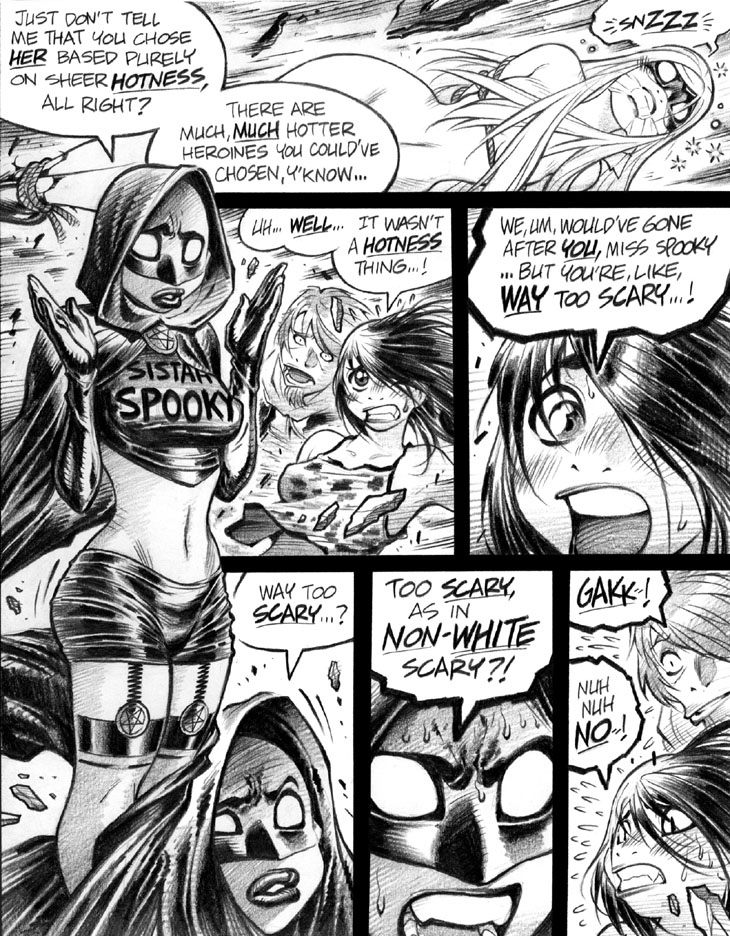Hey, folks, thanks much for the kind responses to the previous page’s query about whether or not readers are getting anything out of this webcomic serialization’s commentaries. Very pleased to hear that people are indeed gleaning some value in this rambling! I’ll definitely have to do something about the Twitter-based commentary rants, though, as several readers mentioned their off-putting format, a problem I’ve noticed myself. Can’t say exactly why the one-tweet-per-paragraph is oddly difficult to read, but I could easily fix that by just compiling multiple tweets into larger paragraphs. Anyhoo, thanks for the input, Empowered (web) readers! And now, on with our regularly scheduled blather.
Note the use, here, of the wonderfully handy manga trope of “figure overlapping multiple tiers of panels down one side of the page.” This is a great way to work in a big, bold full-figure shot—or, here, a mostly full-figure shot—without having to waste most of a comics page to do so, as would be the case with a more literal-minded layout. If I recall correctly, I believe that the great Fred Schodt said in his essential book Manga! Manga! that this visual riff originated in Japanese shoujo (girls’) comics as a way to show a complete, glamorous “fashion shot” of a heroine’s ensemble while still allowing the rest of the comics page to carry out more conventional storytelling. Of course, the concept’s long since seen universalized use in all genres of manga, but I find it interesting to consider its origins.
Ah, but since I didn’t draw Sistah Spooky truly “full-figure,” here, time for a rant-y art-related tangent! See, I find myself constantly eye-rolling at snarky fanboys online who endlessly carp about comic artists not drawing feet in panels or covers or sketches, apparently feeling “cheated” because the ol’ tootsies aren’t in view. Well, lemme explain a few facts of comics-drawing life for those non-artists who incessantly complain about this tragic lack of feet: Invariably, a full-figure shot—complete with feet!—means a smaller-figure shot than the alternative. Note that, importantly, in a “full-fig” shot you can’t place the character’s feet too close to the bottom of the panel, which would be visually awkward; you must leave ample clearance below their feet, which means that figure’s gonna have to be drawn even smaller than you might think to fit the allowed space. The moment that you commit to putting a true full-figure shot in a panel or cover, you’re unavoidably shrinking the character way the hell down.
When I draw con sketches—or most Empowered covers, for that matter—I default to a figure that’s cut off roughly at mid-thigh. Is that because I’m scared of drawing feet? Nope. Rather, I do that to maximize the figure size and amount of space that the character takes up on the page. A figure cut off at mid-thigh can easily fill up an entire piece of art board with a nice, big, striking image, whereas a full-figure shot—complete with those precious feet that some folks seem to obsess over—is necessarily smaller and usually takes up less than third of the available space, unless drawn crouching or kneeling or seated. Plus, the Sharpies I use for rendering con sketches don’t work well with small, full-figure shots on 11” X 14” Bristol board, my sketching medium of choice. Larger characters cut off at mid-thigh, by contrast, work very well indeed with my notably “low-resolution” markers.
-Adam Warren

